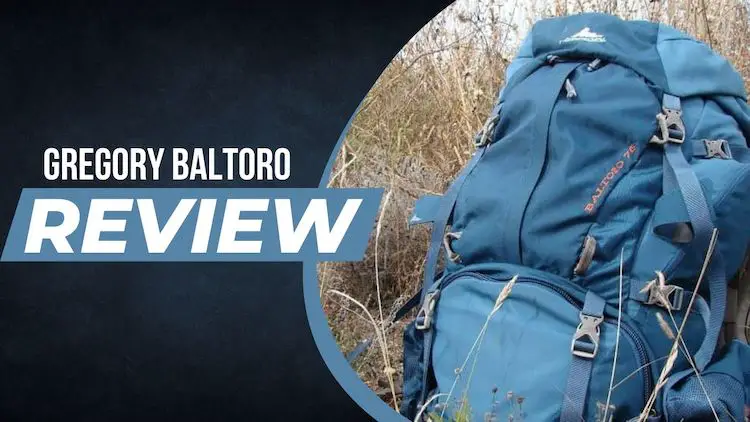Gregory’s flagship packs, the Baltoro for men and the Deva for women, have long been favored by those who carry heavy loads, and the latest iteration of their backpack continues to impress. The Gregory Baltoro 75 is one of the best trekking backpacks out there for travelers looking to carry substantial loads on the trail.
While Gregory did make some omissions with the 2022 model, such as removing the built-in Sidekick daypack, rain cover, and pivoting hip belt, the pack still remains substantial and robust. However, those omissions to the backpack do make it less suitable for those seeking a lightweight and fast travel experience.
If you prioritize enhanced cushioning, organization, and support, the Baltoro remains unrivaled as one of the top choices for demanding loads. In the following review, we cover everything there is to know about the Gregory Baltoro 75 and our firsthand experiences with the backpack!
Disclaimer: This post contains affiliate links which earn us a small commission! If you think the Gregory Baltoro 75 Backpack is right for you and purchase one using our links, we will get enough money to buy a caramel latte while we write our next review!
Quick Facts about the Gregory Baltoro 75
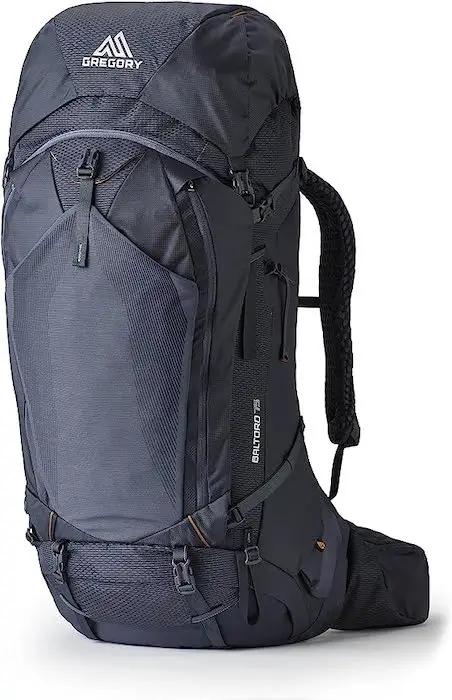
- Price: $350
- Weight: 4 lbs. 15.7 oz. (size medium)
- Fabric: Nylon (210D & 420D)
- Capacities: 65, 75L
- Amazon Rating: (4.5/5) 14 Reviews
- Gregory Website Rating: (4.8/5) 557 Reviews
What we like about the Gregory Baltoro 75
- The Baltoro is as comfortable as ever with a strong suspension and pivoting shoulder straps that carry heavy loads extremely well.
- Fantastic organization: The pack has tons of exterior pockets to distribute gear, and the U-shaped access to the main compartment makes grabbing items that are stuffed away very easy.
- Tough and confidence-inspiring construction with robust fabrics, quality details, and thick reinforcements at the base.
- Thinner padding at the middle of the back provides a boost in airflow with no noticeable impact on comfort.
- Adjustability at the torso and hip belt make dialing in fit quick and easy.
What We Don’t like about the Gregory
- Heavy at nearly 5 pounds and overkill if you pack light or only head out on short summer trips.
- Tall side pockets that flank the mesh shove-it pocket are difficult to access when the pack is full and can only accommodate lower-profile items.
- Lacks wet-weather protection, including no rain cover or weather-resistant fabrics other than a standard DWR coating.
- We liked the prior Baltoro’s pivoting hip belt, although the new system is more customizable and has a sleeker shape.
Performance of the Gregory Baltoro 75:
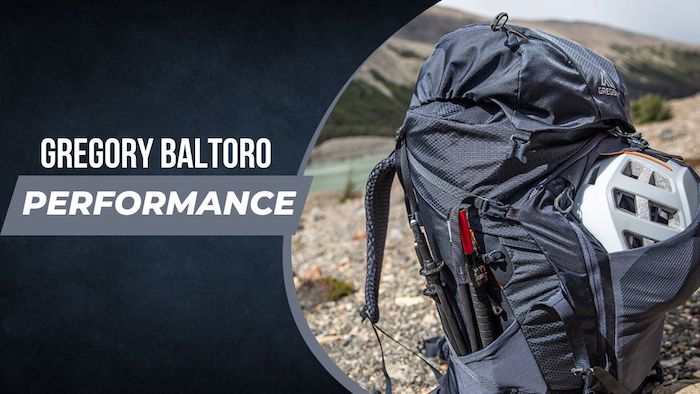
Let’s start the Gregory Baltoro 75 review by looking into the overall performance of the pack. As one of the top rated backpacks out there, it is a great heavy duty backpack that doesn’t sacrifice comfort for heavy loads.
Let’s start by looking at the comfort of the bag.
1. Carrying Comfort of the Gregory
The Gregory Baltoro 75 has always excelled in providing comfort while carrying heavy loads, and the latest model upholds this reputation. As I loaded my 75-liter pack with my usual backpacking gear, along with a few additional items for the monsoon weather in Nepal, I was immediately impressed by the pack’s ability to support and distribute the weight evenly across my body. The full-perimeter metal frame and compression straps create a robust structure, while the high-quality padding on the hip belt and shoulder harness strikes a perfect balance between softness and support, ensuring comfort during long days on the trail. Despite carrying weights of over 40 pounds at times, the Baltoro handled the load exceptionally well, exhibiting minimal movement even on the uneven and rocky terrain along the trek up the mountain.
Beyond its premium cushioning and durable construction, the Baltoro’s pivoting shoulder straps significantly contribute to its comfort while carrying. This feature allows the pack to move in sync with your body while remaining snugly fit, proving particularly beneficial during extended climbs and when navigating technical terrain with speed.
Although the latest model no longer includes a rotating hipbelt like its predecessor, the flex and contoured shape of the current design prevent any discomfort or chafing around the lumbar or hips. Moreover, the new hip belt offers enhanced customization with Velcro attachments that allow you to adjust the placement of the padding, unlike the fixed positioning of the previous iteration. A similar level of adjustability is present in the shoulder straps as well. Overall, this system reminds me of Gregory’s mid-range Paragon series and greatly improves the overall fit and comfort of the pack.
2. Gregory Baltoro 75 Weight
The latest Gregory Baltoro 75 is a substantial pack weighing in at 4 pounds 15.7 ounces for a size medium. When compared to its direct competitors, this weight falls within the average range.
For instance, Osprey’s Aether 65 weighs 4 pounds 14.7 ounces for a size S/M, and their Atmos AG 65 weighs 4 pounds 9 ounces. It’s worth noting that there are significantly lighter options available, such as Hyperlite Mountain Gear’s 4400 Southwest (2 lbs. 7.2 oz.) or ULA’s Circuit 68 (2 lbs. 4.6 oz.), which are designed for ultralight purposes.
However, it’s important to consider that these packs often involve trade-offs in terms of features and carrying comfort. Despite not being featherweight, the Baltoro’s plush padding and ample storage configuration were greatly appreciated when carrying a substantial amount of gear.
3. Organization of the Gregory Baltoro 75
The Baltoro truly excels in providing excellent organization, a significant advantage of a feature-rich and slightly heavier pack. The backpack offers a total of nine well-proportioned exterior pockets. The top lid boasts three zippered pockets for storing small items, while the front section includes two tall zippered pockets, a spacious mesh shove-it pocket, and two mesh water bottle holders. Additionally, the Baltoro features two enclosed hipbelt pockets, which are noticeably larger than those found in the previous model. Furthermore, the combination of large and small pockets on the top lid allows for easy organization and quick access to gear that needs to be kept within reach.
However, the only minor disappointment lies in the tall side pockets flanking the mesh shove-it pocket on the front. These pockets can be challenging to access when the pack is fully loaded. Although these particular pockets may be the least valuable in the overall layout, I still think the rest of the Baltoro’s organization is truly exceptional.
One of my favorite organizational features of the Baltoro is the U-shaped zipper along the front, granting complete access to the main compartment. Unzipping and opening this large flap provides effortless visibility and retrieval of items stored inside the pack. Additionally, there is a separate zippered access point for the sleeping bag compartment at the bottom.
I love these features as it makes it easy to remove, or store jackets and other equipment that you may need frequently throughout the hike. The quick access feature saved a significant amount of time for me, that would have otherwise been spent rummaging or unloading the pack.
4. Backpack Ventilation:
In recent updates, Gregory has made significant improvements to the ventilation of their packs, and the latest iteration of the Baltoro 75 offers the best ventilation yet. Similar to the previous generation, the new model features a sculpted back panel primarily made of mesh, with ample openings in the foam.
We also noticed a significant increase in airflow in the middle of the back, achieved by employing thinner padding. Moreover, the enhancement didn’t compromise on comfort which we were happy to see. Even when facing temperatures above 70s Fahrenheit, I remained pleasantly comfortable.
While Osprey’s Anti-Gravity back panel on their Atmos packs still leads the way in terms of ventilation, thanks to its suspended mesh design that sits further away from your back, the Baltoro is not far behind!
5. Weather Protection
Regrettably, in the latest version of the Baltoro, Gregory has eliminated a few protective features. This includes removing the rain cover and replacing the water-resistant fabric on the hipbelt pockets with standard nylon material.
It’s important to note that the entire pack, including the body, base, and lining, is coated with a durable water repellent (DWR) treatment, which offers some resistance to light moisture. During monsoon season in Nepal, I didn’t run into any issues with rain, or having to set my pack down on the cooler rocks and grass.
However, I recommend not to push the limits of the DWR too much. Moreover, to protect your gear even more you can either waterproof your gear with dry bags or invest in a separate rain cover (available from Gregory for $40) if you anticipate heavy rainfall. Taking these precautions will ensure better protection for your belongings in challenging weather conditions.
6. The Gregory Baltoro 75 Build Quality and Durability:

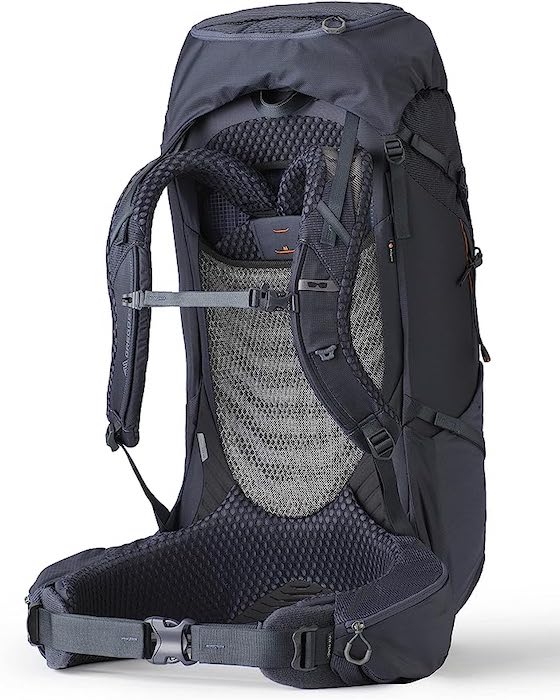
As mentioned earlier, the Gregory Baltoro 75 is undeniably a heavy backpacking pack, weighing in at almost 5 pounds. However, one notable advantage is the utilization of exceptionally sturdy and confidence-inspiring materials throughout its construction.
The pack body strikes a balance between weight and durability, featuring high-quality zippers and a combination of lightweight 210-denier (D) nylon and resilient 420D high-density nylon. Additionally, the base is reinforced with an even thicker 630D nylon. During our testing and review, both the previous generation Baltoro and the latest model emerged with minimal signs of wear, looking nearly new.
The pack’s durability is undoubtedly one of its standout features, particularly appealing to those who frequently venture outdoors and put their gear through demanding conditions.
7. Fit and Sizing
The medium size of the Gregory Baltoro 75 backpack is perfect for individuals around the 18-inch torso and 31-inch waist measurements. The new shoulder strap design features a Velcro setup that allows for precise adjustments (the medium size accommodates torsos ranging from 17 to 20 inches).
The hip belt follows a similar approach with its Velcro system, enabling the cushioning to be shifted up to 3.5 inches from side to side, providing easy customization for optimal comfort. It’s worth noting that the pack is also available in small (suitable for torso lengths of 16 to 19 inches and waist sizes of 26 to 48 inches) and large (designed for torso lengths of 18 to 21 inches and waist sizes of 30 to 52 inches) sizes, offering a range of options to suit different body proportions.
8. Sustainability
In their recent update to the Baltoro collection, Gregory has implemented a range of eco-friendly initiatives which we absolutely love!
One significant change is the incorporation of recycled materials, with the body of the pack now composed of 40-45% recycled nylon, and the lining made from 40% post-consumer recycled polyester. Moreover, they have made the decision to use a PFC-free DWR coating, avoiding the use of environmentally harmful perfluorocarbons.
It’s worth noting that Gregory is not the only pack manufacturer adopting these sustainable practices, but it is commendable to see their commitment to designing products with greater environmental consciousness. Importantly, these eco-friendly modifications have not compromised the performance or durability of the pack, which remains top-notch.
9. Other Capacities and Women’s Gregory Deva
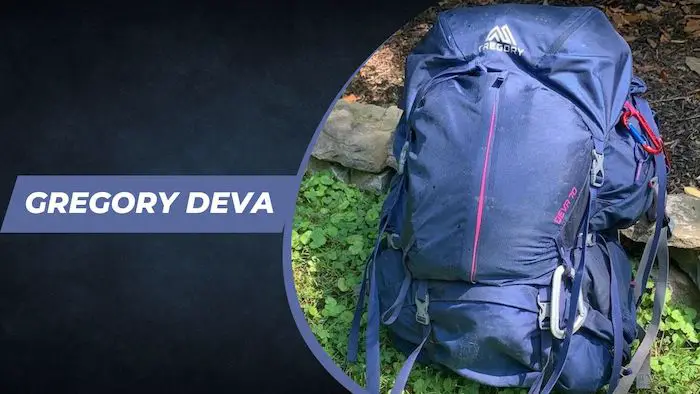
For this review, we tested the 75-liter version of the Baltoro, which offers the largest capacity in the collection, making it ideal for carrying heavy loads over long distances. However, if you’re packing lighter or embarking on shorter trips, it’s worth considering the Gregory Baltoro 65. With a lower price point, it is more affordable and slightly lighter, while still retaining the same set of features and overall build quality.
Women seeking an equivalent option can opt for the Deva, available in 60-liter and 70-liter variations, priced around $320 and $350 respectively. It’s important to note that the Deva includes all the features we admire in the Baltoro, such as the convenient U-shaped access to the main compartment, supportive cushioning, and robust construction.
Gregory Baltoro 75 Competition
Despite the growing popularity of lightweight backpacking gear, there remains a strong demand for heavy-hauling packs that prioritize comfort, and the Baltoro continues to excel in this category. For those seeking a slightly smaller but still supportive and feature-rich option from Gregory, the Paragon 68 is worth considering. Weighing in at 3 pounds 11.4 ounces for the medium/large size and priced at a reasonable $270, the Paragon offers a compelling alternative for those looking to reduce weight and save some money. However, the Baltoro outshines the Paragon in terms of capacity (by 7 liters), external storage (with more external pockets), and comfort, thanks to its heavily padded hip belt and shoulder straps.
One of the long-standing competitors to the Baltoro is Osprey’s Aether series. In comparison, the Osprey Aether 65 comes with a higher price tag and a heavier weight of 5 pounds 9.7 ounces (for the S/M size). However, it compensates with ample storage and attachment points, including ice ax loops and trekking pole carriers, as well as extensive adjustability in the hipbelt, shoulder straps, and torso. The Aether also features a removable top lid that converts into a daypack and an integrated rain cover, both of which Gregory omitted in the latest Baltoro update. While the Aether has its merits, it’s difficult to justify the higher cost for less capacity.
Last but not least, the Osprey Atmos AG 65 is our top pick for an all-around backpacking pack. While it offers 10 liters less capacity, which is still ample for most multi-day trips given the streamlined gear options available today, the Atmos excels in other areas. Unlike the Baltoro, it lacks zippered access to the main compartment, but it compensates with a lighter weight and a lower price. The Atmos manages to provide nearly the same level of comfort as the Baltoro while being more budget-friendly and breathable. If you’re seeking a more streamlined alternative that makes minimal compromises, the Atmos 65 is an excellent choice.
Gregory Baltoro 75 Review is it worth it?
Gregory’s flagship packs, the Baltoro for men and the Deva for women, continue to be highly regarded choices for trekkers who carry heavy loads. Despite some omissions in the Gregory Baltoro 75 packs in2022 model, such as the removal of the built-in Sidekick daypack, rain cover, and pivoting hip belt, the Baltoro remains a substantial and robust backpack.
It may not be ideal for lightweight and fast travel, but if your priorities lie in enhanced cushioning, organization, and support, the Baltoro stands unrivaled as one of the best options for demanding loads. Our comprehensive review provides detailed insights and firsthand experiences with the Gregory Baltoro 75, making it clear why this backpack is an excellent investment for trekkers.
In this review of the Gregory Baltoro 75, we took a deep dive into what the backpack has to offer. If you think this bag is right for your next adventure, consider using the link below to make a purchase – it will help us continue to publish reviews like this!

- Price: $350
- Weight: 4 lbs. 15.7 oz. (size medium)
- Fabric: Nylon (210D & 420D)
- Capacities: 65, 75L
- Amazon Rating: (4.5/5) 14 Reviews
- Gregory Website Rating: (4.8/5) 557 Reviews
